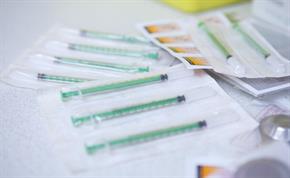Date:
19 April 2024
Page URL:
https://ntk.eastamb.nhs.uk/news/guidance-for-needlestick-and-splash-incidents.htm?pr=
Guidance for needlestick and splash incidents

Occupational exposure incidents are where a member of staff has been exposed to blood or body fluids.
This can happen through:
- a needle stick injury – defined as any contaminated needle or other sharp object which punctures the skin
- a splash – defined as any splash of blood or body fluids to the mucous membranes or open wounds.
In the event of an occupational exposure incident it is important that you are aware of the correct procedure to follow. If the incident is high risk and post exposure prophylaxis (PEP) is required, this is more effective the earlier it is started and should ideally be underway within two hours of the incident.
The Trust procedure for managing any occupational exposure incident is:
IMMEDIATE ACTION
- Bleed it: encourage the wound to bleed
- Wash it: wash the wound with soap and running water
- Cover it: Dry the wound and cover it with a waterproof plaster
- Do not: scrub the wound while washing it or suck the wound
- For splash incidents- rinse with copious amounts of water
- Inform EOC that you have sustained a needlestick / splash injury and need to attend A&E.
ASSESSMENT
- Member of staff to be seen in A&E
- A&E staff will conduct a risk assessment
- A&E will provide initial assessment and treatment (you may be given a Hep B booster or PEP if required).
REPORT THE INCIDENT
- Contact occupational health (PAM) at the earliest possible opportunity on 0330 6600365 for advice, counselling and to arrange the appropriate follow-up care, including blood tests where required. It is essential that you inform PAM what the outcome of the assessment in A&E was and what, if any treatment was provided.
- Report the incident to line manager
- Report the incident on Datix.
When you contact PAM, they will go through a telephone assessment which should cover the below information:
- The nature of the incident
- What emergency first aid actions were taken
- Attendance at A&E and what actions taken there
- Gain information regarding the source – determine if blood sample obtained from source
- Obtain information as to what the risk assessment level was determined - for example high (puncture injury form known drug user, sex worker, person known to have BBV), medium – blood stained
- Bodily fluids into scratch, eyes, nose mouth are considered low risk – only bodily fluids onto intact skin
- Consideration of need for PEP in high risk cases
- Current Hep B status
- Giving employee EAP/counselling information
- Advising those high and medium risk on precautions that may be necessary until blood test results known
- Discuss any follow-on care which may be required, e.g. follow on blood tests at six, 12 & 24 weeks.
Further information regarding occupational exposure incidents can be found in the IPC Manual on stations or in the Trust IPC Safe Practice Guidelines.
